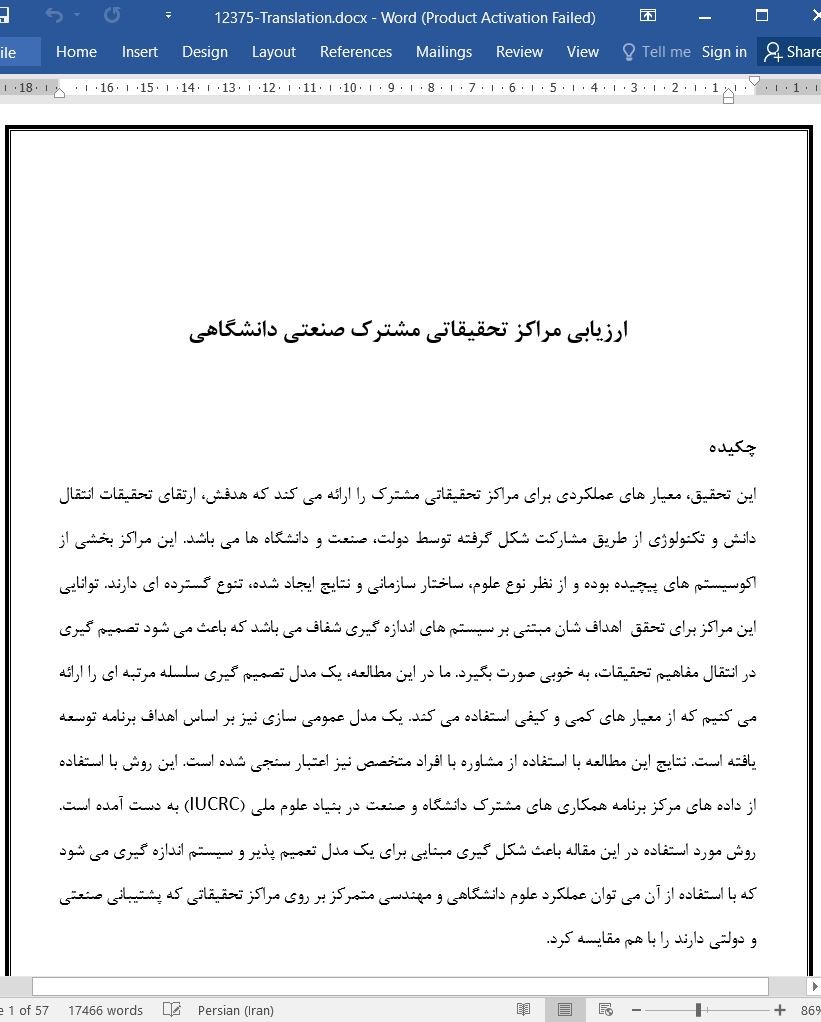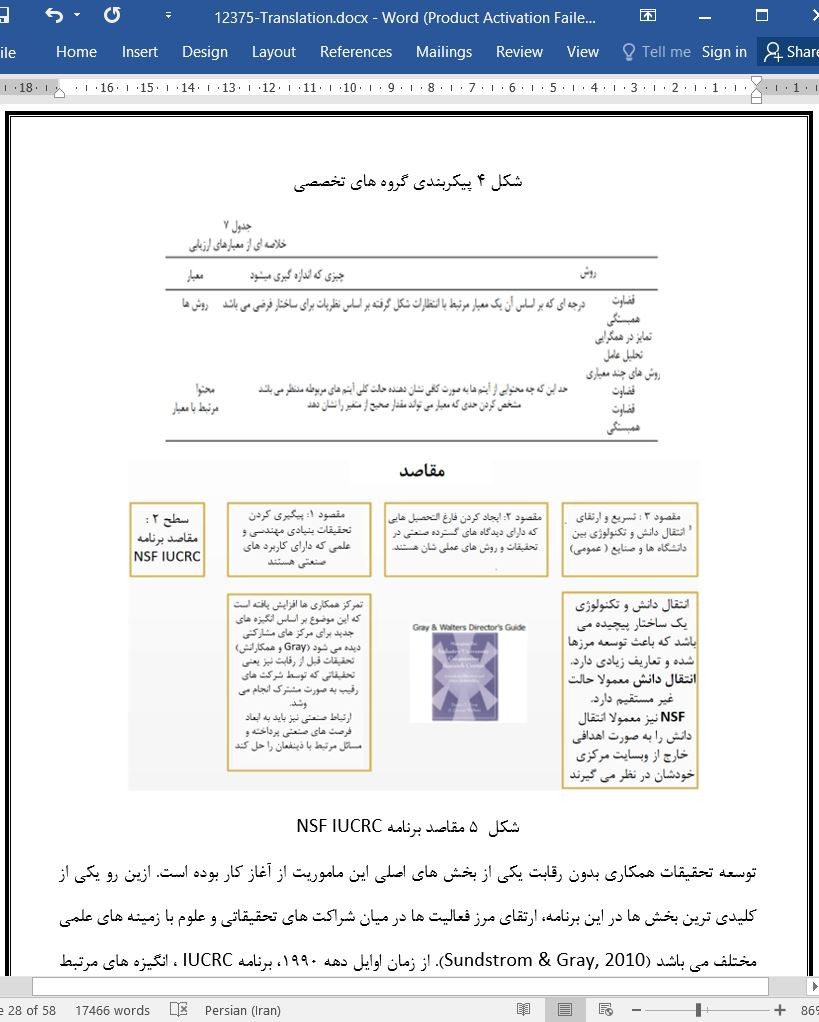
ارزیابی مراکز تحقیقاتی مشترک صنعتی دانشگاهی
چکیده
این تحقیق، معیار های عملکردی برای مراکز تحقیقاتی مشترک را ارائه می کند که هدفش، ارتقای تحقیقات انتقال دانش و تکنولوژی از طریق مشارکت شکل گرفته توسط دولت، صنعت و دانشگاه ها می باشد. این مراکز بخشی از اکوسیستم های پیچیده بوده و از نظر نوع علوم، ساختار سازمانی و نتایج ایجاد شده، تنوع گسترده ای دارند. توانایی این مراکز برای تحقق اهداف شان مبتنی بر سیستم های اندازه گیری شفاف می باشد که باعث می شود تصمیم گیری در انتقال مفاهیم تحقیقات، به خوبی صورت بگیرد. ما در این مطالعه، یک مدل تصمیم گیری سلسله مرتبه ای را ارائه می کنیم که از معیار های کمی و کیفی استفاده می کند. یک مدل عمومی سازی نیز بر اساس اهداف برنامه توسعه یافته است. نتایج این مطالعه با استفاده از مشاوره با افراد متخصص نیز اعتبار سنجی شده است. این روش با استفاده از داده های مرکز برنامه همکاری های مشترک دانشگاه و صنعت در بنیاد علوم ملی (IUCRC) به دست آمده است. روش مورد استفاده در این مقاله باعث شکل گیری مبنایی برای یک مدل تعمیم پذیر و سیستم اندازه گیری می شود که با استفاده از آن می توان عملکرد علوم دانشگاهی و مهندسی متمرکز بر روی مراکز تحقیقاتی که پشتیبانی صنعتی و دولتی دارند را با هم مقایسه کرد.
1. مقدمه
همکاری های بین دانشگاه و صنعت تحقیقات چند زمینه ای را انجام می دهند که برای حل کردن مسائل پیچیده اجتماعی، ضروری هستند ( Boardman and Gray, 2010). افزایش پشتیبانی های سیاسی عمومی ایالات متحده برای ابتکار عمل هایی که باعث ارتقای تحقیقات ترجمانی می شود، باعث شکل گیری تکامل در بسیاری از انواع مکانیزم های انتقال تکنولوژی شده است (Boardman and Bozeman, 2015). امروزه، تحقیقات مبتنی بر دانشگاه ها به عنوان مکانیزم های سیاسی و راهبرد های صنعتی، قابل استفاده هستند [[(Boardman and Ponomariov, 2011) pg 76)]. مرکز تحقیقات مشترک (CRC ها) شامل توافق نامه های مشارکت با عاملان مختلف از بخش های دولتی، صنعتی و دانشگاهی هستند که بهترین مدل های پایدار تجاری را ارائه می کنند. اما، پشتیبانی از این ترکیب های سه بخشی (Etzkowitz and Leydesdorff, 2000a) یا ساختار دولت – دانشگاه – صنعت (GUI) فرایندی گران می باشد و باعث شده است که سیاست گذاران مجبور شوند توجه خودشان را به ارزیابی عملکرد، معطوف کنند (Carayannis et al., 2014a).
6.2 تاثیرات کاربردی
تاثیر بعدی در نتیجه گسترش مدل و نتایج آن برای بهبود ارزیابی برنامه های NFS IUCRC ایجاد می شود. این مطالعه این مدل را تست کرده و روش را با ارزیابی شش IUCRC مختلف ارائه کرده است. بسیاری از مطالعات این سوال را مطرح می کنند که آیا شاخص های کتاب شناسی رایج ، شاخص های صحیح هستند و همیشه این اخطار را مطرح می کنند که این شاخص ها ممکن است یک تصویر ناقص را ارائه کنند (Wagner et al., 2011). نتایج این تحقیق، شواهد پشتیبانی را برای این جریان از مقالات ارائه می کنند و یک روش جدید را ارائه می کنند که به صورت محسوس، اهداف انتقال دانش و تکنولوژی را در نظر دارد. CRC هایی که از بودجه های فدرال استفاده می کنند باید در تصمیم گیری های خودشان شفافیت داشته باشند. این تحقیقات، یک روش جدید را ارائه می کند که نشان دهنده عدم توافق هایی می باشد که باعث می شود مباحث و فرایند تصمیم گیری شفاف، بهبود پیدا کند.
Abstract
This research provides performance metrics for cooperative research centers that enhance translational research through partnerships formed by government, industry and academia. Centers are part of complex ecosystems and vary greatly in the type of science conducted, organizational structures and expected outcomes. The ability to realize their objectives depends on transparent measurement systems to assist in decision making in research translation. We introduce a hierarchical decision model that uses both quantitative and qualitative metrics. A generalizable model is developed based upon program goals. The results are validated through consultation with experts. The method is illustrated using data from the National Science Foundation's industry/university cooperative research center (IUCRC) program. The methodology provides a basis for a generalizable model and measurement system to compares performance of university science and engineering focused research centers supported by industry and government.
1. Introduction
Industry-university collaborations conducting multi-disciplinary research are required to solve increasingly complex social problems (Boardman and Gray, 2010). Increased U.S. public policy support for initiatives that enhance translational research has resulted in the evolution of many different forms of technology transfer mechanisms (Boardman and Bozeman, 2015). Today, university-based research centers “are prevalent as both policy mechanisms and industry strategies” [(Boardman and Ponomariov, 2011) pg 76]. Cooperative research centers (CRCs) that involve partnership agreements with actors from three different sectors of government, academia and industry are the most sustainable business models (Lee, 2000). However, supporting these “triple-helix” (Etzkowitz and Leydesdorff, 2000a) or governmentuniversity-industry (GUI) (Carayannis et al., 2014a) collaborations is expensive, driving policy makers to shift their attention towards performance evaluation.
6.2. Application contributions
The next contribution follows as a result of the first by disseminating the model and results of the study for improved assessment in the NSF IUCRC program. This study tested the model and the method by evaluating six (6) alternative IUCRCs. Many studies question if the traditional bibliometric indicators are the “right ones” and caution that they paint a “partial picture”(Wagner et al., 2011). The results of this research provide supporting evidence to this stream of literature by finding that new methods contribute significantly higher towards knowledge and technology transfer objectives than licenses. Federally funded CRCs are required to have transparency in their decision making processes. This research provides a new method that highlights disagreements helping to drive discussions and transparent decision making processes.
چکیده
1. مقدمه
2. مروری بر مقالات
2.1 برنامه ریزی تکنولوژی ملی
2.2 مرکزهای تحقیقاتی فنی
2.3 روش های ارزیابی
3. روش شناسی
3.1 مدل های تصمیم گیری با چند معیار
3.2 مدل تصمیم گیری سلسله مرتبه ای
4. توسعه مدل
4.1 گروه های متخصص
4.2 بخش های مدل
4.3 مدل نهایی
5. کاربرد مورد پژوهی
5.1 پیش زمینه مورد پژوهی
5.2 جمع آوری داده ها
5.3 نتایج
6. جمع بندی
6.1 تاثیرات تحقیقاتی
6.2 تاثیرات کاربردی
منابع
ABSTRACT
1. Introduction
2. Literature review
2.1. National technology planning
2.2. Technology research centers
2.3. Evaluation methods
3. Methodology
3.1. Multi criteria decision models
3.2. Hierarchical decision model
4. Model development
4.1. Expert panels
4.2. Model components
4.3. Final model
5. Case study application
5.1. Case study background
5.2. Data collection
5.3. Results
6. Conclusions
6.1. Research contributions
6.2. Application contributions
References
- اصل مقاله انگلیسی با فرمت ورد (word) با قابلیت ویرایش
- ترجمه فارسی مقاله با فرمت ورد (word) با قابلیت ویرایش، بدون آرم سایت ای ترجمه
- ترجمه فارسی مقاله با فرمت pdf، بدون آرم سایت ای ترجمه



